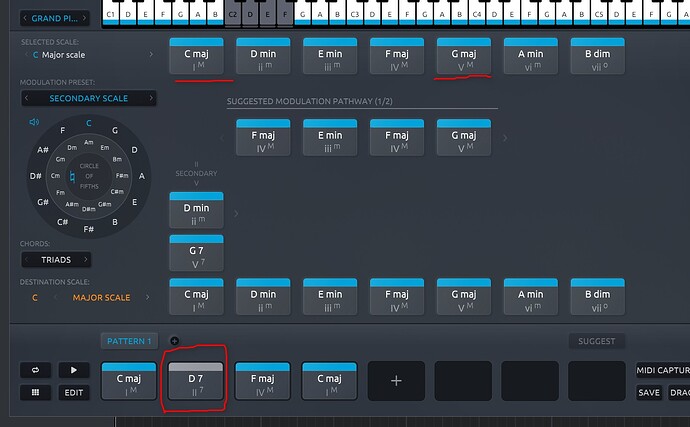For modes, watch Jake’s videos on modes, he has a whole bunch of them, and they’re great.
Think of a secondary dominant like “the 5, of the 5” (5 being V)
in C Major, your I chord is C Major, your V chord is G Major, now to find the secondary dominant, you treat that G as if it is your I chord, and from there go to the V, in G Major, the V chord is DMaj <— this D is what is called the secondary dominant.
So if you want to end on the I chord of your current scale, coming from a secondary dominant, you’d go V/V > V > I.
~ V/V just means 5 of 5, it tends to be written like that, the first one is the chord your playing, the second where it came from, so V/ii means the 5 of your 2, IV/iii means the 3 of your 4 etc.
~~ Another note, the V is the Dominant scale degree (it’s the “name” of V, the rest are listed below, using Major as the reference).
I - Tonic
ii - Supertonic
iii - Mediant
IV - Subdominant
V – Dominant
vi – Submediant
vii°– Leading Tone
The confusing thing in learning about secondary dominants is that the word dominant is also used as a name for a certain chord. Example: adding a B note on top of your C chord, that makes it a C Major 7 chord (C, E, G, B) (written as I-Maj7 in C Major, because C is your I) , but if you add a bB instead (1 note/semitone/“a half step” down from B), then that chord is called C Dominant 7 (which, if in C Major, would be written as I-7). This has nothing to do with the dominant scale degree, they just have the same word in the name, I remember this being confusing for me too  (the same word being used for multiple different things is a common thing in music theory, it’s good to keep that in mind)
(the same word being used for multiple different things is a common thing in music theory, it’s good to keep that in mind)
So the V7/ii in your screenshot specifically means playing a dominant seventh chord (that’s what the 7 in V7 stands for) on the 5th scale degree (that’s what the V in V7 stands for) of the ii chord (2nd scale degree), which in C Major would be the note A7. Cause you’d go:
“Start at C”
“find your ii, that’s D”
“find the V of D, which is A”
“play that A chord as a dominant seventh chord, which makes it A7”
for the question: “Are Secondary Dominant chords only available in major keys?”
I don’t have the knowledge to answer this properly, as I’m not sure if you mean “from the key you are currently in”, or “in the key that the secondary dominant comes from”, and I think there was something about how minor v’s don’t “function” like major V’s (look up functional harmony and/or roman numeral notation, it’s there somewhere) but I can’t remember the specifics.
P.S. I have no formal theory education or anything, but as far as I know this “should” all be correct, not counting formatting formalities like using the ° symbol for the Leading Tone scale degree, which I assume to be technically incorrect, but for the purposes of this explanation combined with the way it’s presented in Scaler it makes more sense.








![Secondary Dominants- Write Better Chord Progressions! [MUSIC THEORY / SONGWRITING]](https://canada1.discourse-cdn.com/flex012/uploads/scalermusic/original/2X/9/92f4b26ce31b540b9835ec08e30ecfc4de214df6.jpeg)
 (the same word being used for multiple different things is a common thing in music theory, it’s good to keep that in mind)
(the same word being used for multiple different things is a common thing in music theory, it’s good to keep that in mind)